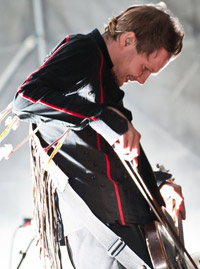
Outdoor venues may not always be the best sites to see bands with the level of sonic detail that Sigur Rós has, unless one is privileged enough to be very close to the stage. However, it also feels borderline immoral to contain such a lush sweeping sound indoors. Seven years elapsed between the last Sigur Rós show in Indianapolis, an indoor affair at North America’s largest Shriners temple, and the show that just occurred at the Lawn at White River State Park on Tuesday, September 17th.
Those patient enough to have waited that long probably couldn’t compare notes between shows. This time, Sigur Rós played as an eleven-piece. Most of those in the band played multiple instruments, faithfully recreating every sound composed on record, as well as adding much more to those familiar sounds. What stood out most was singer Jónsi Birgisson’s voice. Any fan knows this is an asset to the band, but only live can his full talent be appreciated.
 As a contrast to the massive setup of Sigur Rós, opener Julianna Barwick was primarily alone. She looped soft high vocals and liquid keyboard notes into ethereal, drone-y soundscapes. The only accompaniment was an occasional electric guitar providing texture. There was a likeness to the gentlest moments of Sigur Rós, only stretched out without an overt progression or release. This led to a lack of variety, making a set only 30 minutes long seem to drag on.
As a contrast to the massive setup of Sigur Rós, opener Julianna Barwick was primarily alone. She looped soft high vocals and liquid keyboard notes into ethereal, drone-y soundscapes. The only accompaniment was an occasional electric guitar providing texture. There was a likeness to the gentlest moments of Sigur Rós, only stretched out without an overt progression or release. This led to a lack of variety, making a set only 30 minutes long seem to drag on.
Sigur Rós had large-scale visuals to go with their large-scale sound. A large screen behind the stage played abstract moving scenes while many lone light bulbs were scattered around the stage on stands. These were only occasionally used, but often along with flare-like bursts on the screen, giving a feeling of physical depth to the projected scene. This otherworldly lighting went especially well with their newer material. As startlingly aggressive and percussive as their most recent album, Kveikur (QRO review), is at times, this was amplified live. Songs like “Hrafntinna” and “Brennisteinn” clattered and burned through the air respectively.
 Older songs were played faithfully and occupied much of the set. Hearing new material against this cinematic backdrop accentuated how much of a departure these songs really are, at least on the surface. These two sides came together in the finale, “Popplagið”. This old favorite, already climactic in that distinctly Sigur Rós way, absolutely shredded, surpassing the intensity of even their newest material. It was the perfect way to end the set, making music that can sometimes seem formless decidedly concrete. A distinctly breezy and cool night on the way out seemed to almost be a form of tactile feedback from their last notes.
Older songs were played faithfully and occupied much of the set. Hearing new material against this cinematic backdrop accentuated how much of a departure these songs really are, at least on the surface. These two sides came together in the finale, “Popplagið”. This old favorite, already climactic in that distinctly Sigur Rós way, absolutely shredded, surpassing the intensity of even their newest material. It was the perfect way to end the set, making music that can sometimes seem formless decidedly concrete. A distinctly breezy and cool night on the way out seemed to almost be a form of tactile feedback from their last notes.




















